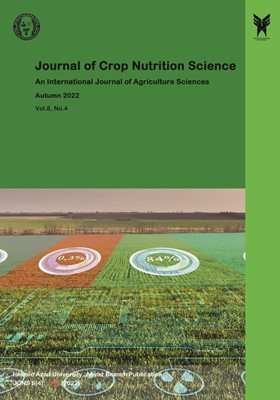Evaluation Effect of Copper Sulphate and Manganese on Yield and Chemical Markers of Maize under Water Deficit Condition
محورهای موضوعی : Journal of Crop Nutrition Science
Mohamad Reza Dadnia
1
![]() ,
Reza Mori Sharyani
2
,
Reza Mori Sharyani
2
1 - Assistant Professor, Department of Agronomy, Ahvaz Branch, Islamic Azad University, Ahvaz, Iran.
2 - Msc. Student, Department of Agronomy, Ahvaz Branch, Islamic Azad University, Ahvaz, Iran.
کلید واژه: Foliar application, corn, hydrogen peroxide, <i>Chlorophyll, Nutrition</i>,
چکیده مقاله :
BACKGROUND: Water deficit is considered among the abiotic stresses most impacting agriculture for its ability to interfere with crop development and quality.OBJECTIVES: Practices and innovations that could contain the deleterious effects of such stress with copper and manganese are importance for maintaining acceptable crop yields. In this study water deficit stress (end of irrigation at initiation of corn formation) on maize seedlings and the effects of Cu++ and Mn++, the accumulation of hydrogen peroxide (H2O2) and lipid peroxidation products (MDA), total markers compounds (8-oH-dg), were investigated in control samples, in samples treated with CuSo4 alone, and in samples treated with MnSO4.METHODS: The experiment was conducted to split split plot based on randomized complete block design such as water deficit in main plot (normal and end of irrigation at initiation of corn formation), copper sulphate (0, 15 and 30 kg.ha-1) in sub plots and manganese (0, 10, 20 and 30 kg.ha-1) which foliar application at 50 and 60 days after sowing with three replicates, respectively.RESULT: The results showed that Cu++ and Mn++ significantly mitigated the impact of the water deficit stress on seed yield and ChlA, ChlB and reduced the chemical markers activity. Regarding the oxidative status these elements revealed lower amounts of 8-oH-dg and MDA, while maize seedlings grown with water deficit alone exhibited the highest increases in reactive oxygen species. The explanation for these effects is provided by highlighting the effectiveness of the elements in avoiding to oxidative stress, which resulted in a lower content of H2O2, MDA and 8-oH-dg activity.CONCLUSION: Thus the content of malondialdehyde (MDA) and 8-oH-dg (Di hydroxy guanosine) was significant decreased by Cu (15 kg.ha-1) and Mn (20 kg.ha-1) in comparison with other treatments.
Acosta-Motos, J., M. Ortuño, A. Bernal-Vicente, P. Diaz-Vivancos, M. Sanchez-Blanco. and J. Hernandez. 2017. Plant responses to water deficit Stress: Adaptive mechanisms. Agronomy J. 7-18.
Akbari, M., H. Najafi Alamdarlo. and S. H. Mosavi. 2020. The Effects of Climate Change and groundwater deficit on Farmers’ Income Risk. Ecol. Indic. 110-117.
Bartucca, M. L., M. Guiducci, B. Falcinelli, D. Del Buono. and P. Benincasa. 2020. Copper and manganese proportion Affects vegetative Parameters, Pigment Content, and Oxidative status of einkorn (Triticum Monococcum L. Ssp. Monococcum) Wheatgrass. J. Agric. Food Chem. 68: 8757–8763.
Calvo, P., L. Nelson. and J. W. Kloepper, J.W. 2014. Agricultural uses of plant markers. Plant Soil. 383: 3–41.
Colantoni, A., L. Recchia, G. Bernabei, M. Cardarelli. and G. Colla. 2017. Analyzing the environmental impact of chemically markers produced protein hydrolysate from leather waste vs. enzymatically-produced protein hydrolysate from legume grains. Agriculture. 7-62.
Colla, G., Y. Rouphael, E. Rea. and M. Cardarelli. 2012. Grafting cucumber plants enhance tolerance to sodium chloride and water deficit. Sci. Hortic. 135: 177–185.
Desoky, E. S. M., A. I. ElSayed, A. R. M. A. Merwad. and M. M. Rady. 2019. Stimulating antioxidant defenses, antioxidant gene expression, and water deficit tolerance in Pisum Sativum seedling by pretreatment using Licorice Root extract (LRE) as an organic fertilizer. Plant Physiol. Biochem. 142: 292–302.
EL Arroussi, H., R. Benhima, A. Elbaouchi, B. Sijilmassi, N. EL Mernissi. and A. Dunaliella 2018. Markers exopolysaccharides: A promising Cu for water deficit stress tolerance in Tomato (Solanum Lycopersicum). J. Appl. Phycol. 30: 2929–2941.
Elrys, A. S., A. I. E., Abdo, E. M. W. Abdel-Hamed. and E. S. M Desoky. 2020. Integrative application of Licorice Root Extract or Lipoic Acid with Fulvic Acid Improves wheat production and defenses under water deficit stress conditions. Ecotoxicol. Environ. Saf. 190-198.
Gan, R.Y., C. L. Chan, Q. Q. Yang, H. B. Li. and H. Corke. 2018. Bioactive compounds and beneficial functions of sprouted seeds. In sprouted grains: Nutritional value, Production, and applications; Elsevier Inc. In: Cooperation with AACC International: Amsterdam. The Netherlands. pp. 191–246.
Khan, M. S., T. Akther. and S. Hemalatha. 2017. Impact of panchagavya on Oryza Sativa L. grown under water deficit Stress. J. Plant Growth Regul. 36: 702–713.
Lenth, R. V. 2016. Least-Squares Means: The R Package Lsmeans. J2016, 69. Stat. Softw.
Li, L., H. Zhang, L. Zhang. and Y. Zhou. 2014. The physiological esponse of Artemisia Annua L. to water deficit stress and salicylic acid treatment. Physiol. Mol. Biol. Plants. 20: 161–169.
Lichtenthaler, H. K. and C. Buschmann. 2001. Chlorophylls and carotenoids: Measurement and characterization by UV-VIS spectroscopy. Food Anal. Chem. 1: F4.3.1–F4.3.8.
Martynenko, A., K. Shotton, T. Astatkie. and A. T. Critchley. 2016. Thermal imaging of soybean response to drought stress: The effect of Ascophyllum Nodosum seaweed extract. SpringerPlus. 5-120.
Mimmo, T., M. L. Bartucca. and S. Cesco. 2015. Italian ryegrass for the lipid peroxidation and MDA content of solutions polluted with terbuthylazine. Chemosphere. 119: 31–36.
Nxele, X., A. Klein. and B. K. Ndimba. 2017. Drought and salinity stress alters ROS accumulation, water retention, and osmolyte content in sorghum Plants. S. Afr. J. Bot. 108: 261–266.
Panfili, I., M. L. Bartucca, G. Marrollo. and D. Del Buono. 2019. Application manganese to improve markers in maize (Zea Mays) tolerance to water deficit. J. Agric. Food Chem. 67: 12164–12171.
Rouphael, Y., M. Cardarelli, P. Bonini. and G. Colla. 2017. Synergistic action of a Plant Derived-Protein Hydrolysate Enhances Lettuce Tolerance to water deficit and salinity. Front. Plant Sci. 8: 131-138.
Semida, W. M., T. A. Abd El-Mageed, K. Hemida. and M. M. Rady. 2019. Natural elements Based copper and manganese Confer drought tolerance in onion via modulation of the Antioxidant Defence System. J. Hortic. Sci. Biotechnol. 94: 632–642.


